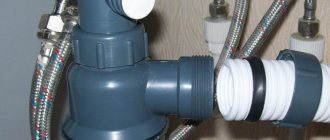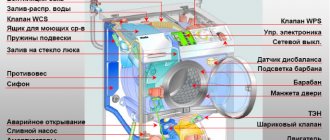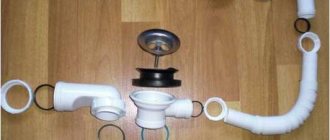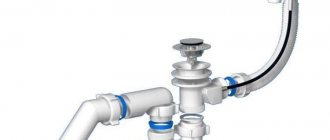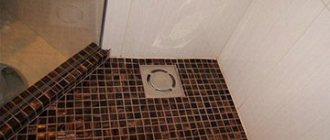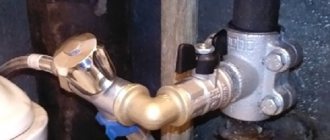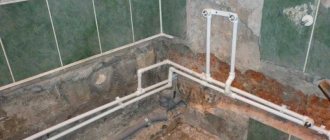An unpleasant situation when wastewater from the sewer enters the washing machine tank. A “swampy” smell and dirty laundry are guaranteed. This can happen due to improper connection of the machine to the drain. But what to do if the realities of life are completely incompatible with the installation instructions? In this case, a non-return valve for the washing machine will help. This special device allows used liquid to flow in only one direction. Useful information about this detail within the article.
Self-installation
The purpose of a check valve, unlike a fill valve, is to block the return of waste water to the washing machine drum. You can install it yourself.
One side of the valve is connected to a siphon or sewer pipe, and the other to a drain hose. The joints are firmly fixed and sealed.
Features of use
The choice of device directly depends on the condition of the tap water. With good quality water, it is advisable to change the valve once every couple of years. The segment element is used to work with low-quality water; it is necessary to periodically disassemble it and clean it of debris and scale.
Not all household appliance companies provide a check valve in the basic kit. For example, they come included with Miele washing machines, but it is better to check this with a consultant when purchasing, because Models may vary. If the valve is not included in the kit, it can be immediately purchased separately from a specialized store.
Connecting a drain using a valve makes it possible not to follow the recommendations for the height of the drain hose. It is important during use to ensure free access to the valve in case of cleaning or repair.
Under the influence of hard tap water, the valve quickly fails, which is the reason for frequent (every few years) purchase of a new one. Therefore, it is worth paying attention to the price - low cost does not guarantee good quality of the product.
When is it necessary to put
There are several reasons when an antisiphon is needed. See which case is yours. If you have doubts that the washing machine is installed correctly, we recommend reading this article, which shows a working connection diagram:
Step-by-step instructions for connecting any washing machine
With direct discharge to the sewer
The outlet hose is inserted directly into the sewer outlet. Of course, the connection method is very simple.
But there is a risk that used water will return from the sewer to the drum. Especially if the outlet level is significantly lower than the tank level.
Hence the disgusting smell of things after washing. Installing a check valve solves this problem once.
Wrong outlet level
The main rule for installing a drain hose is that its end should be 50 cm above the floor level. Sometimes, for aesthetic reasons, the hose is placed very low and you get that “siphon effect” with all that it entails: dirty water and the smell in the machine.
The sewer system is not done according to the rules
Perhaps the sewage system in the house is outdated or was originally assembled incorrectly. Inappropriate pipe diameter, incorrect slope, lack of water seal.
Unpleasant smell
A nasty smell in the place where the machine is located is an absolute indication for installing a check valve. It will block not only the flow of wastewater, but also the sewer smell.
How does it work?
A check valve is a fairly simple device made of stainless metal or plastic. In appearance, it is a bit like a shut-off valve, and its operating principle is similar. An anti-siphon is needed to regulate the flow of water in the pipe, allowing it to move only in one direction.
Initially, the check valve is in a locked state, but when the drain mode is activated, it opens under the pressure of water. When the drain program is turned off, the valve automatically closes, preventing water from returning.
Principle of operation
The antisiphon can be spring or ball. When the machine pumps out water, the pump (drain pump) creates pressure in the hose. Under pressure, a spring or ball is pressed against a special membrane, lifting the elastic band by 1-2 centimeters, and water flows freely. Then the pressure disappears, the shutter part returns to its place, tightly closing the passage. No waste water or odors can enter the machine.
There are several types of check valve:
- Whole. As the name suggests, it cannot be disassembled and cleaned. Such an antisiphon lasts 2-3 years. Then you have to change the whole thing. And if the water in your area is heavy or dirty, then earlier.
- Segmental. Consists of several collapsible parts. This valve can be disassembled and cleaned regularly. Sometimes a bellows connection is used to eliminate unnecessary vibrations.
- Wall-mounted. If aesthetics are important to you, then choose this option. This siphon is made of chromed metal or brass. It is installed on the pipe as close to the wall as possible or walled into it. It will be very appropriate if there is little space between the back panel of the washing machine and the wall.
- Mortise. Mounted directly into the pipe.
- Washing. Attaches to the siphon under the sink.
What is a check valve and its types
If the sewer connection is not properly connected, dirt from the drain can flow into the tank, which increases energy costs and damages things.
A non-return valve for a washing machine, called an anti-siphon, prevents this and protects the drain system. This small piping element is suitable for any model of washing machine. Despite the damper, it does not interfere with the drainage of water. The quality of the wash depends on the type of check valve and manufacturer.
Types of check valve
There are:
- washing valve;
- non-separable;
- segmental;
- mortise;
- wall-mounted
They differ from each other in minor points. But, for example, when installing an LG model washing machine, you only need a segment valve . This type is excellent at disassembling and cleaning from various blockages.
The non-separable type is a good option for soft water plumbing, but this does not mean that it will last for a long time. Its service life is approximately 2-3 years.
If there is a very narrow space between the wall and the back cover of the washing machine, then a wall valve with a compact and pleasant appearance is an excellent option.
Its downside is the price, which is quite high.
A mortise device is often installed when it is necessary to install a direct drain into a sewer pipe.
It got its name from the special insert into which it is inserted.
If the valve needs to be installed in the sink siphon, then you can safely consider the washing type , which will fit under any sink.
Tips and tricks
We have collected tips from master plumbers. We hope you find them useful.
Install in an easily accessible place
The outlet valve of the washing machine, installed on the drain, becomes clogged and breaks over time. And installing it in a place where it is difficult to reach will only complicate your life. In an emergency, you will need to quickly disassemble the valve, clean it or make repairs so that the laundry does not have time to be in dirty water.
Which to choose
List of the most reliable and popular check valves
- Italian exhaust valve Type: mortise. Body material: polypropylene. Installed in a drain pipe or attached to a hose to drain water. The mechanism is based on a spring with a rubber membrane.
- Czech valve from . Wall. The plastic case contains a water seal made of a ball with a spring. Universal: suitable for any hose. The main advantage is the affordable price.
- In third place is another representative of Italy from. The body is made of polypropylene. Installed in a siphon under the sink. The mechanism is spring.
- Mini-siphon from the Russian manufacturer ANI Plast. Mounts anywhere on the pipe. The locking mechanism consists of a spring-loaded polymer ball. The polypropylene body is resistant to aggressive environments and temperature changes.
- Siphon for connecting a washing machine from the Scottish company McALPINE. The beautiful plastic chrome-plated body does not spoil the aesthetics of the interior. Standard water seal with polymer ball and reflector.
Is it really necessary or how can I do it myself?
You can do without additional expenses by making the shutter yourself, using a standard corrugated hose that goes from the machine to the sewer. This is done simply - the hose needs to be organized so that the top point is above the level of the washing machine tank. The laws of physics and gravity will not allow the liquid to flow back into the “washer”.
But this is not a solution to the problem, but only a temporary solution. The fact is that the pump wears out due to the long hose and its bend. The pump has to work hard to move water through such a distance. In addition, cleaning turns into torture, since you have to completely disconnect it from the washing machine.
When connecting a hose to drain water directly to the sewer, use a rubber coupling. It will make the connection more airtight.
With this method, the waste pipe outlet must be raised 50 cm from the floor. Otherwise, the water seal will not work.
The hose may also not be long enough. To extend it you will need a piece of a similar hose and a special coupling. But over time, water begins to leak at the junction.
Variety of anti-siphon devices
Reverse siphoning prevents the use of a special water intake pipe with a siphon (see what a siphon is here) by connecting the pipe itself to the atmosphere. But there are also other effective methods for solving this problem.
So, if the drain pipe runs directly behind the washing machine, then you can try installing a coupling - a connecting sleeve for hoses with a built-in valve that stops the reverse flow.
Such connectors can be different: with short tips specifically for the hose itself, which is attached to the back of the machine to the outlet pipe, or connected to the water intake pipe itself.
Antisiphons are:
- collapsible
- non-separable
- mortise
- washing
Tips for choosing
- Experts say that not all models of drain valves are suitable for your washing machine. The service center will help you choose the appropriate antisiphon. You can also seek advice from an experienced technician who specializes in repairing washing machines.
- The best recommendations are for check valves from European manufacturers. The equipment receives a large number of positive reviews from the Italian companies Siroflex and Merloni, as well as from the Czech company Alcaplast.
Antisiphon
A check valve for a washing machine on the drain (anti-siphon), mounted on the drain system, in order to prevent waste liquid from returning from the sewer pipes to the tank of the washing machine.
The non-return (anti-siphon) hydraulic valve does not interfere with the planned outflow of dirty water from the tank of the automatic machine. And if there is an attempt to return it from the sewer pipe to the tank, the damper in the valve design immediately blocks its path. In order to purchase and install the necessary drain valve, you need to decide on the types of these devices.
Siphon effect
The manifestation of such an unpleasant phenomenon - arbitrary drainage of water into the sewer system or the return of it (liquid) from the sewer into the washing machine tank, is typical for washing machines and dishwashers installed in apartments located on the upper floors of multi-storey buildings. This does not exclude its (“siphon effect”) manifestation in the rooms of the lower levels, if washing equipment is installed incorrectly.
That is, when the outlet end of the tube is below the water level in the tank, as a result of which the water rises and returns to the tank or is spontaneously discharged. The result of this is excessive consumption of electricity and water or laundry spoiled by sewer liquid that needs to be washed again. Avoiding these unpleasant moments is quite simple. You need to buy and install a washing machine water drain check valve. This can be done by calling a plumber or doing it yourself, especially installing a check valve (anti-siphon), the operation is not complicated and does not require special tools.
Should it be replaced with something else?
A check valve for a washing machine is not such a rare product, but it is not always possible to find it in stores, especially if you live in a small town. Therefore, many are interested in the question: is it possible to use something else to prevent the siphon effect?
Unfortunately, the answer to this question will be negative. There are no analogues to the antisiphon yet. To do without it, you will have to organize the drain in such a way that all elements of the system are positioned as expected, and then there will be no siphon effect.
